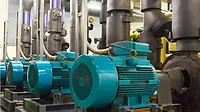Pump standards make the word go ‘round
Experts laud the most influential guidance advancing pump system design.

Image courtesy of Andrey Suslov / iStock / Getty Images Plus.
It is in the interest of regulators, engineers, contractors, architects and system owners to find the most efficient paths to pump system solutions. The rising tide of standards plays a significant role in elevating the performance, reliability and quality of pump systems — minimizing the trial and error it often takes to arrive at the solutions best suited for the application. However, some standards stand out for the magnitude of their impact.
Success starts with setting procedures for testing
The Hydraulic Institute (HI), is an accredited standards development organization by the American National Standards Institute (ANSI). HI has published 35 pump standards and guidelines, most of which reach consensus via the ANSI essential requirements and are then published as American National Standards. That makes it difficult to narrow the list down to the most transformative guidance, but a few stand out as being particularly necessary to the industry, including ANSI/HI 14.6 Rotodynamic Pumps for Hydraulic Performance Acceptance Tests.
Updated in 2016, ANSI/HI 14.6 sets the standard used by purchasers and manufacturers for the acceptance of rotodynamic pumps (centrifugal, mixed flow and axial flow pumps). The acceptance tests outlined in the standard include: Hydraulic Performance Testing, Hydrostatic Pressure Testing, Mechanical Integrity Testing, and Net Positive Suction Head (NPSH) Testing. The criteria described in the standard cover types of factory performance tests, test arrangements, permissible device uncertainty and measurement fluctuations, and for performance tests, the acceptance grades and tolerance bands that can be applied to the guaranteed point. Core to the standard, are three test grades and six tolerance bands that are applied unilaterally or bilaterally to the guaranteed point for flow and total head. Default acceptance grades broken down by industry are provided in the standard, but if a purchaser desires a different acceptance grade than the default, they can specify it.
ANSI/HI 14.6 is so important because it creates common ground criteria for all manufacturers to follow for testing equipment, as well as common criteria for acceptance of that equipment. An end user can request a pump to a specific acceptance grade and have assurance the pump will perform properly in the field. That is a level of specificity, understanding and efficiency that would not be possible without this standard.

Intake design standard minimizes time spent on scale models
In the Army Corp of Engineers, we design water pumping infrastructure as part of our civil works mission. In doing so, we use many submersible pumps, so we reference ANSI/HI 11.6 Rotodynamic Submersible Pumps: for Hydraulic Performance, Hydrostatic Pressure, Mechanical and Electrical Acceptance Tests for the unique testing of submersible motor pumps. This standard requires that the submersible pump is guaranteed and tested as a complete close-coupled unit. Another standard we utilize is ANSI/HI 9.8. ANSI/HI 9.8 Rotodynamic Pumps for Pump Intake Design is a major time-saver in helping our teams determine the required dimensions including height and length and width of pumping stations.
The standard is designed to help contractors and engineers optimize efficiency and flow. It addresses rectangular intakes, formed suction intakes, circular pump stations, trench-type intakes for clear liquids and for solids-bearing liquids, pump suction for tanks, can vertical turbine pump intakes, and unconfined intakes. The standard also helps understand how to configure a functional pumping facility around pump geometry and the size of inlet connection. This facilitates a uniform flow of liquid into the eye of the impeller for efficient, reliable operations with less vibration.
In a real word example to illustrate the importance of this standard, we designed a pump station at our lock at Sault St. Marie, Michigan, where we were tight on space. Physical modeling is sometimes necessary but often takes significant time. While the software for modeling pump stations has come a long way, it’s not advanced enough to be solely relied upon without physical modeling. We utilized ANSI/HI 9.8 and our own engineering manuals (which HI helped update) to save time while minimizing the footprint. It’s worth acknowledging the importance of the sizing criteria since building a scale model is both time-consuming and expensive and some pump stations are so large in height and width that they can easily create sub-optimal flow conditions. ANSI/HI 9.8 is critical to moving as quickly and smoothly through the design process as possible. Additionally, HI is currently working on an update to this standard that addresses Computational Fluid Dynamics (CFD) simulation parameters. Though a physical model may always be necessary, it would be a great leap forward for engineers to rely on CFD modeling software and use physical models for validation. That scenario could be on the horizon.
These standards and guidelines will continue to be important to pump system design and assessment in the future. As with most guidance, they must evolve with changes in the industry, adapting alongside new trends or challenges.
Determining acceptable pump piping and vibration requirements
A companion to ANSI/HI 9.8, ANSI/HI 9.6.6 Rotodynamic Pumps for Pump Piping, addresses pump piping requirements, particularly straight-run requirements and piping design guidance. The 9.6.6 standard has guided our designers on minimum suction pipe straight run requirements and considerations if unable to accommodate the minimum values in retrofits.
Additionally, ANSI/HI 9.6.4 Rotodynamic Pumps for Vibration Measurement and Allowable Values sets vibration acceptance criteria and measurement methods for rotodynamic pumps. This standard is utilized to provide guidance on vibration measurement and the associated acceptance criteria to determine if a new installation is acceptable from a vibration perspective. In addition, we use this standard as a benchmark for existing pumps to determine relative change from initial baseline as well as to assess how much the pumping units have migrated from acceptable vibration characteristics due to wear, system changes, conditions of service changes, etc.
These standards and guidelines will continue to be important to pump system design and assessment in the future. As with most guidance, they must evolve with changes in the industry, adapting alongside new trends or challenges. The ANSI-driven five-year review cycle facilitates regular updates and provides a means to consider the market changes. For example, we’ve witnessed a transition from a pump focus to a system focus within many HI publications. Now, industrywide attention is shifting to the development of efficient pumping systems designed to minimize energy usage while also enhancing pump service life. I expect the Department of Energy regulations could lead to pump efficiency and pump system optimization requirements and guidance expanding within several HI standards, guidelines, and guidebooks to a greater degree if the regulation scope continues to grow with additional market segments, pump types, accessories, and more.
For more information on ANSI/HI Standards, click here.
Looking for a reprint of this article?
From high-res PDFs to custom plaques, order your copy today!







